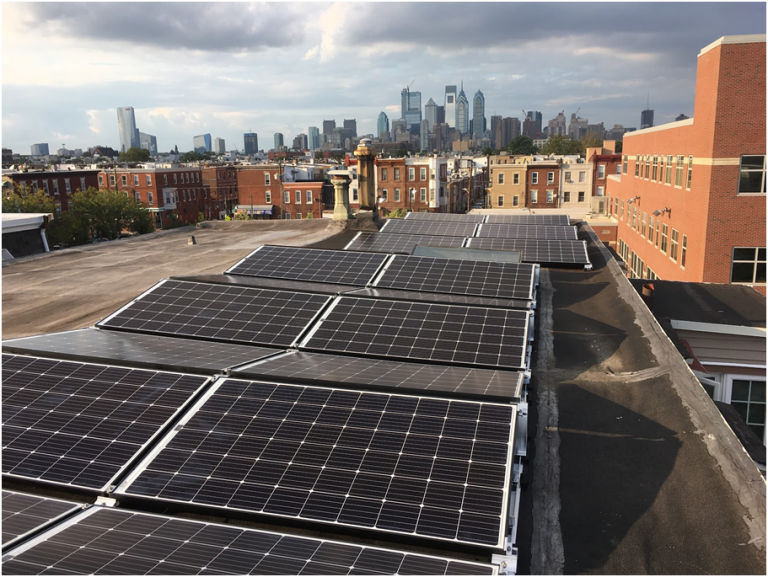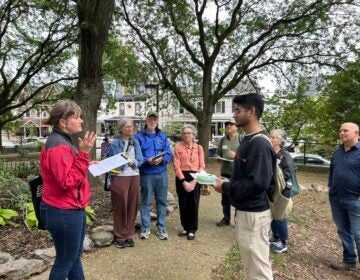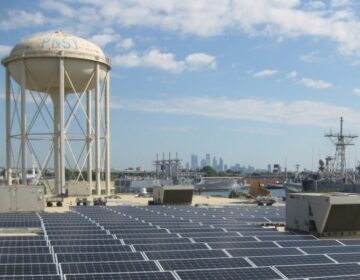Solar ‘ambassadors,’ discounts on installations all part of Philly’s plan to make 2019 the year of sun power
Anyone who owns property in Philly can sign up to receive a free solar assessment of their home or business. 2019 is the last year to qualify for a 30% federal tax credit.

Anyone who owns property in Philly can sign up to receive a free solar assessment of their home or business. 2019 is the last year to qualify for a 30% federal tax credit. (Courtesy of Solar States)
This story originally appeared on PlanPhilly.
—
Victor Young paid $370 for electricity a month before solar panels were installed in his roof last year. Now his electric bill is zero, and he only pays $126 a month on the loan that financed the panels. The rooftop installation will be paid off in six years.
“It’s [a] no brainer,” he said. “Just think of the savings. I was consuming electric at a phenomenal pace, and it was costing me a lot.”
Not only will his two daughters now inherit a house with no energy bills, Young feels like his turn to renewables is making a better world for his future generations, including a grandchild on the way. Young worked for more than 30 years removing snow with the Streets Department and the warmth of recent Philadelphia winters signals to him a need to do things differently.
“The planet is warming, there’s no doubt,” Young said. “It’s not so [scary] for me, but for that grandchild that I was just informed about — how is she or he going to live, based on what’s happening now?”
Young installed solar energy in his house through Solarize Philly, a group-buying program managed by the Philadelphia Energy Authority. The program was created to entice homeowners to install rooftop panels by offering cheaper than market prices, consumer protections, and a faster process for obtaining city permits. Under the program, anyone who owns property in Philadelphia can sign up to receive a free solar assessment of their home or business from now on until Sept. 30.
The end game for the city is a transition to clean energy while creating 10,000 jobs over 10 years.
The program has succeeded in increasing the number of solar roofs in the city — Philadelphia is listed now as the fourth fastest-growing solar market in the country.
Despite that achievement, the city has fallen short meeting the program’s ambitious goals. So far, 363 residents have installed solar through the program — 186 in 2017 and other 163 in 2018; the goal was to complete 500 by the end of 2018. On that metric, the city made it 72% of the way there, earning a low C. In terms of direct jobs, the goal was to create 75 but the city produced only 52 — 69%, a D+.
“Even though last year was the biggest year ever for solar in Philadelphia, we’re not on track to meet our climate goals,” Mayor Jim Kenney said Tuesday at a press conference announcing the third phase of the program. “We need to ramp up from hundreds of installs each year, to thousands.”
Laura Rigell, the program’s manager at the Philadelphia Energy Authority, said they’re looking at new ways to bring more people into the program in its third year. These strategies include recruiting homeowners like Young as ambassadors of the program, expanding the low-and moderate-income program started last year, and bringing the cost of installing solar even lower. The price will come down through new bulk buying tactics and using economies of scale. A request for proposals for solar equipment vendors is currently open.
PEA is also urging homeowners to take advantage of a federal tax credit that starts to phase out by 2020.
“2019 is the year to go solar,” said PEA’s director Emily Schapira. “Climate change is happening faster than we thought, and the 30% federal investment tax credit for solar is only in place through the end of this year.”
By increasing solar installations, PEA hopes to accelerate the creation of solar jobs. According to a study conducted for the city by the American Council for an Energy-Efficient Economy, 15 living wage jobs are created for every 100 solar installations.
Solarize Philly has trained high school students and adults for solar jobs for the last two years, in collaboration with the Energy Coordinating Agency and Philadelphia OIC. Last year, PEA was selected for a $1.25 million award from the U.S. Department of Energy to train more than 100 students in three years.
“I’ve been on numerous jobs with my instructor since graduating, and I’ve only graduated last Friday,” said Anwar Ahmaddiya, a 39-year-old contractor that joined a solar training because he realized it was an opportunity to expand his business while doing something good for the environment.
Ahmaddiya said he already has two jobs lined up, one in North Carolina and one in Maryland. His plan is to get a North American Board of Certified Energy Practitioners Board Certification for solar professionals and double his monthly income.
Hanifah Davis El, 49, said she joined a training for the same reasons. She has five kids to support and wanted a skill that could increase her job opportunities.
“I think it will be a win-win,” she said. “I will fulfill my mother’s concerns of having a retirement plan, I will definitely contribute to doing my part for my environment, my planet, and I’ll provide jobs for my children and other children,” Davis El said.
Davis El is even thinking of installing solar panels on her own house, in Cobbs Creek, to take advantage of the 30% federal tax credit.
“So I’ll probably be one of those 2019 people to get on it,” she said.
WHYY is your source for fact-based, in-depth journalism and information. As a nonprofit organization, we rely on financial support from readers like you. Please give today.







